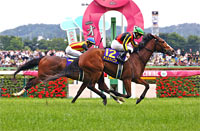Yushun Himba (Japanese Oaks) (G1) - Data Analysis
Top contest of three-year old fillies to deliver thrilling spectacle
The Yushun Himba (Japanese Oaks) is one of the pinnacles of racing for three-year-old fillies. Winners of this race have subsequently turned in spectacular performance. Examples include 2018 winner Almond Eye, who went on to secure the highest number of turf G1 victories (nine) in JRA history (a monumental achievement), and 2019 winner Loves Only You, who became the first Japanese-trained horse to dominate a Breeders’ Cup race. Which runner will shine at the 84th Japanese Oaks? To answer this question, we take a look at trends in this race over the last 10 years.
Focus on favoritism, but leave room for dark horses
Looking at performances by runners over the last 10 years in terms of favoritism, we find that race favorites achieved a Top 3 ratio of 80.0%, delivering excellent performance. The race favorites in the last two years were beaten to 4th or lower, with the victory in both cases going to the runner backed as 3rd favorite. Since 2014, all winners have been backed as 3rd favorite or higher. However, in the last four years, we have seen cases of runners backed as 10th favorite or lower entering the Top 3, such as 2021 third-place finisher Hagino Pilina (16th favorite) in 2021, leading to high payouts on bets. Focusing on runners backed as 3rd favorite or higher would therefore appear to be the prudent strategy, but we should also factor in the possibility that poorly favored runners may chase the top places. [Table 1]
[Table 1] Performance by favoritism (last 10 years)
| Favoritism |
Performance
[1st-2nd-3rd-4th or lower] |
Win ratio |
Top 2 ratio |
Top 3 ratio |
| 1st favorite |
5-2-1-2 |
50.0% |
70.0% |
80.0% |
| 2nd favorite |
1-2-3-4 |
10.0% |
30.0% |
60.0% |
| 3rd favorite |
3-0-1-6 |
30.0% |
30.0% |
40.0% |
| 4th favorite |
0-1-1-8 |
0% |
10.0% |
20.0% |
| 5th favorite |
0-1-1-8 |
0% |
10.0% |
20.0% |
| 6th-9th favorite |
1-2-1-36 |
2.5% |
7.5% |
10.0% |
| 10th favorite or lower |
0-2-2-83 |
0% |
2.3% |
4.6% |
Runners coming from the Oka Sho or a 2,000m turf race fare well
The Japanese Oaks is the second leg of the Classic races for fillies. Seven of the 10 winners over the last 10 years came from the Oka Sho (Japanese 1000 Guineas), the first leg of the same Classic races. This was also true for over half (16) of the Top 3 finishers. Among runners coming from other races, those that had previously contested a 2,000m turf race warrant attention. In this group, we should focus on runners coming from the Sankei Sports Sho Flora Stakes (Japanese Oaks Trial), which produced seven Top 3 finishers including 2021 winner Uberleben, as well as those coming from the Wasurenagusa Sho , which delivered two winners (Mikki Queen in 2015 and Loves Only You in 2019). [Table 2]
[Table 2] Performance by previous race (last 10 years)
| Previous race |
Performance
[1st-2nd-3rd-4th or lower] |
Win ratio |
Top 2 ratio |
Top 3 ratio |
Oka Sho
(Japanese 1000 Guineas) |
7-4-5-62 |
9.0% |
14.1% |
20.5% |
| Wasurenagusa Sho |
2-0-1-9 |
16.7% |
16.7% |
25.0% |
Sankei Sports Sho Flora Stakes
(Japanese Oaks Trial) |
1-4-2-38 |
2.2% |
11.1% |
15.6% |
| Sweet Pea Stakes |
0-1-0-13 |
0% |
7.1% |
7.1% |
| Flower Cup |
0-1-0-8 |
0% |
11.1% |
11.1% |
Satsuki Sho
(Japanese 2000 Guineas) |
0-0-1-0 |
0% |
0% |
100% |
| 1-win class race |
0-0-1-15 |
0% |
0% |
6.3% |
| Race other than the above |
0-0-0-2 |
0% |
0% |
0% |
Discount runners with 2 career starts and those with 7 or more career starts
Looking at performances by runners over the last 10 years in terms of career starts, we observe that 11 of the 30 Top 3 finishers had 5 careers starts, and 10 had 4 career starts. Runners in these two groups achieved relatively high Top 3 ratios. Runners with 6 career starts did not have a particularly strong Top 3 ratio, but produced the last two consecutive winners: Uberleben in 2021 and Stars on Earth in 2022. Conversely, runners with 2 career starts delivered zero Top 3 finishers, while runners with 7 or more career starts only produced one Top 3 finisher: 2022 runner-up Stunning Rose. From this perspective, therefore, runners with 3 to 6 career starts seem to be ideal candidates. [Table 3]
[Table 3] Performance by total career starts (last 10 years)
| Total career starts |
Performance
[1st-2nd-3rd-4th or lower] |
Win ratio |
Top 2 ratio |
Top 3 ratio |
| 2 |
0-0-0-6 |
0% |
0% |
0% |
| 3 |
2-0-1-15 |
11.1% |
11.1% |
16.7% |
| 4 |
3-4-3-25 |
8.6% |
20.0% |
28.6% |
| 5 |
2-5-4-28 |
5.1% |
17.9% |
28.2% |
| 6 |
3-0-2-33 |
7.9% |
7.9% |
13.2% |
| 7 or more |
0-1-0-40 |
0% |
2.4% |
2.4% |
Focus on runners with 3 or more wins in JRA races
Looking at performances by runners over the last 10 years in terms of number of wins, we note that 19 of the 30 Top 3 finishers had secured 3 or more victories in JRA races. Within this group, runners with 5 or fewer career starts delivered five winners, six runners-up and four thirds out of 23 runnersm with excellent Top 3 ratio of 65.2%. Also, this group has produced Top 3 finishers in every year since 2014. Runners with this profile are therefore optimal contenders for Top 3 finishers. Finally, runners with only 1 previous win struggled with a lackluster Top 3 ratio of 5.0%. [Table 4]
[Table 4] Performance by number of wins in JRA races (last 10 years)
| Number of wins |
Performance
[1st-2nd-3rd-4th or lower] |
Win ratio |
Top 2 ratio |
Top 3 ratio |
| 3 or more |
6-7-6-21 |
15.0% |
32.5% |
47.5% |
| 2 |
3-2-4-88 |
3.1% |
5.2% |
9.3% |
| 1 |
1-1-0-38 |
2.5% |
5.0% |
5.0% |
Seek out the winner!
Check career performance and finish in previous race
The last nine winners had suffered either zero or, at most, one defeat to 4th or lower, delivering consistent performance leading up to the race. Another shared feature among the nine winners was that they had all finished in the Top 3 of their previous race. Runners that fulfill these two conditions should be regarded as likely win contenders, and we can focus on favoritism to further narrow down our selection. As illustrated in Table 1, the last nine winners had all entered the race backed as 3rd favorite or higher. We should take all these factors into consideration to look for a runner with a high probability of winning. [Table 5]
[Table 5] Winners’ favoritism, career performance, and finish in previous race (last nine years)
| Year |
Winner |
Favoritism |
Career performance |
Finish in previous race |
| 2014 |
Nuovo Record |
2nd favorite |
2-1-1-1 |
3rd |
| 2015 |
Mikki Queen |
3rd favorite |
2-2-0-0 |
1st |
| 2016 |
Sinhalite |
1st favorite |
3-1-0-0 |
2nd |
| 2017 |
Soul Stirring |
1st favorite |
4-0-1-0 |
3rd |
| 2018 |
Almond Eye |
1st favorite |
3-1-0-0 |
1st |
| 2019 |
Loves Only You |
1st favorite |
3-0-0-0 |
1st |
| 2020 |
Daring Tact |
1st favorite |
3-0-0-0 |
1st |
| 2021 |
Uberleben |
3rd favorite |
1-1-3-1 |
3rd |
| 2022 |
Stars on Earth |
3rd favorite |
2-3-1-0 |
1st |
(Maya Takanami)
|




















